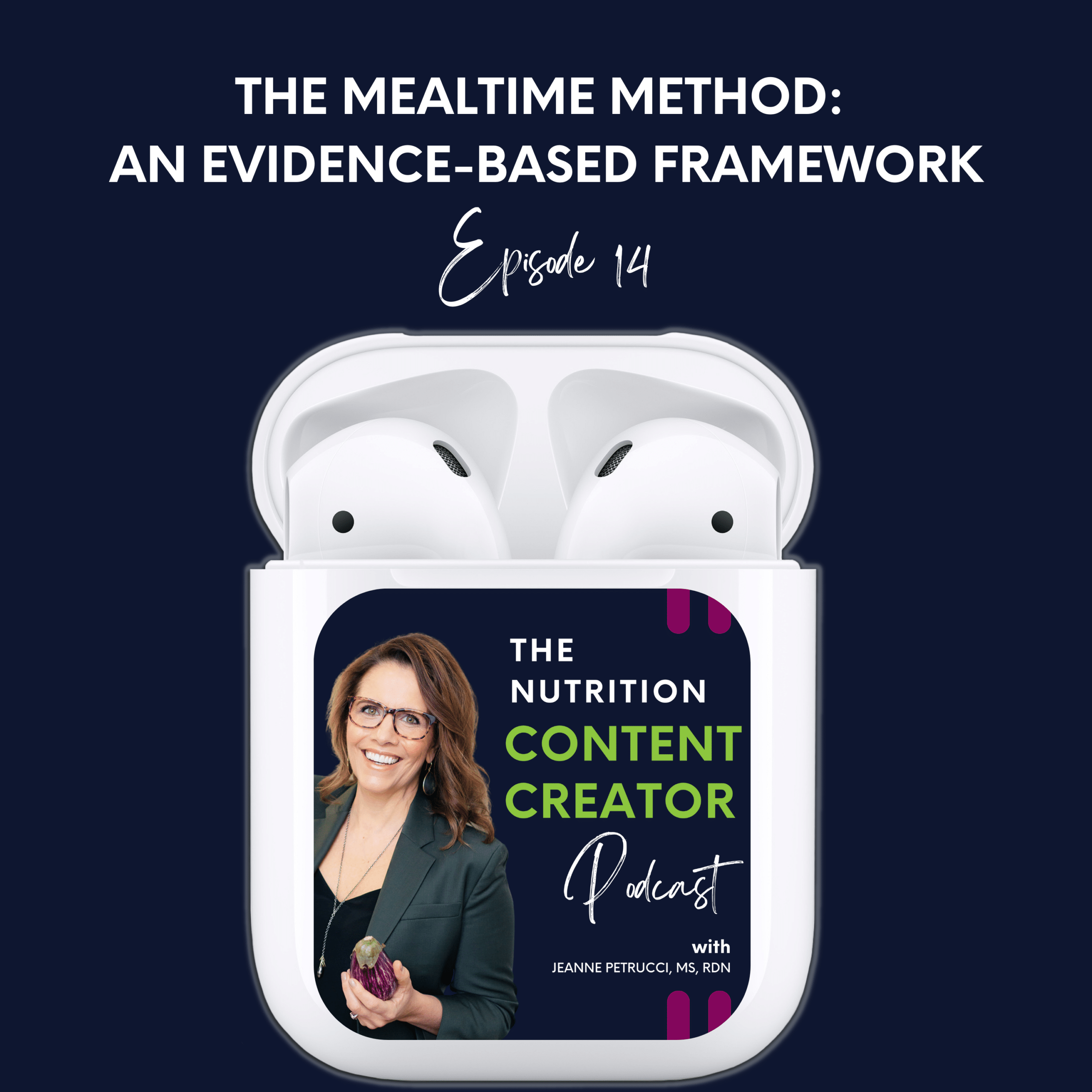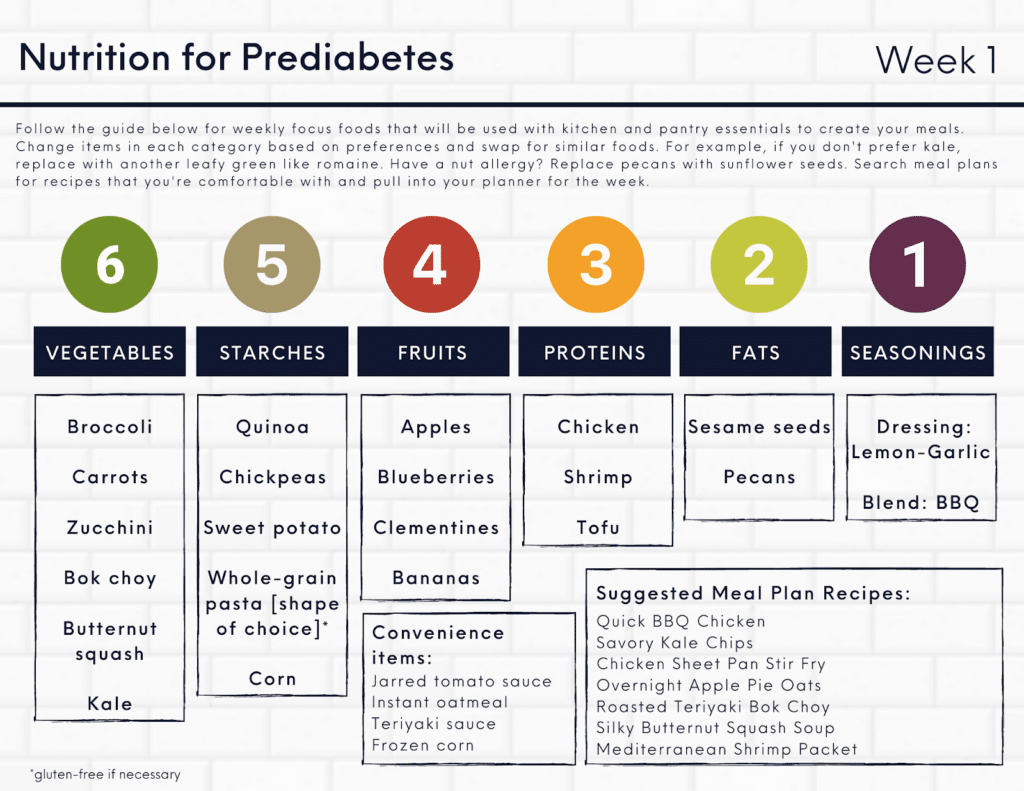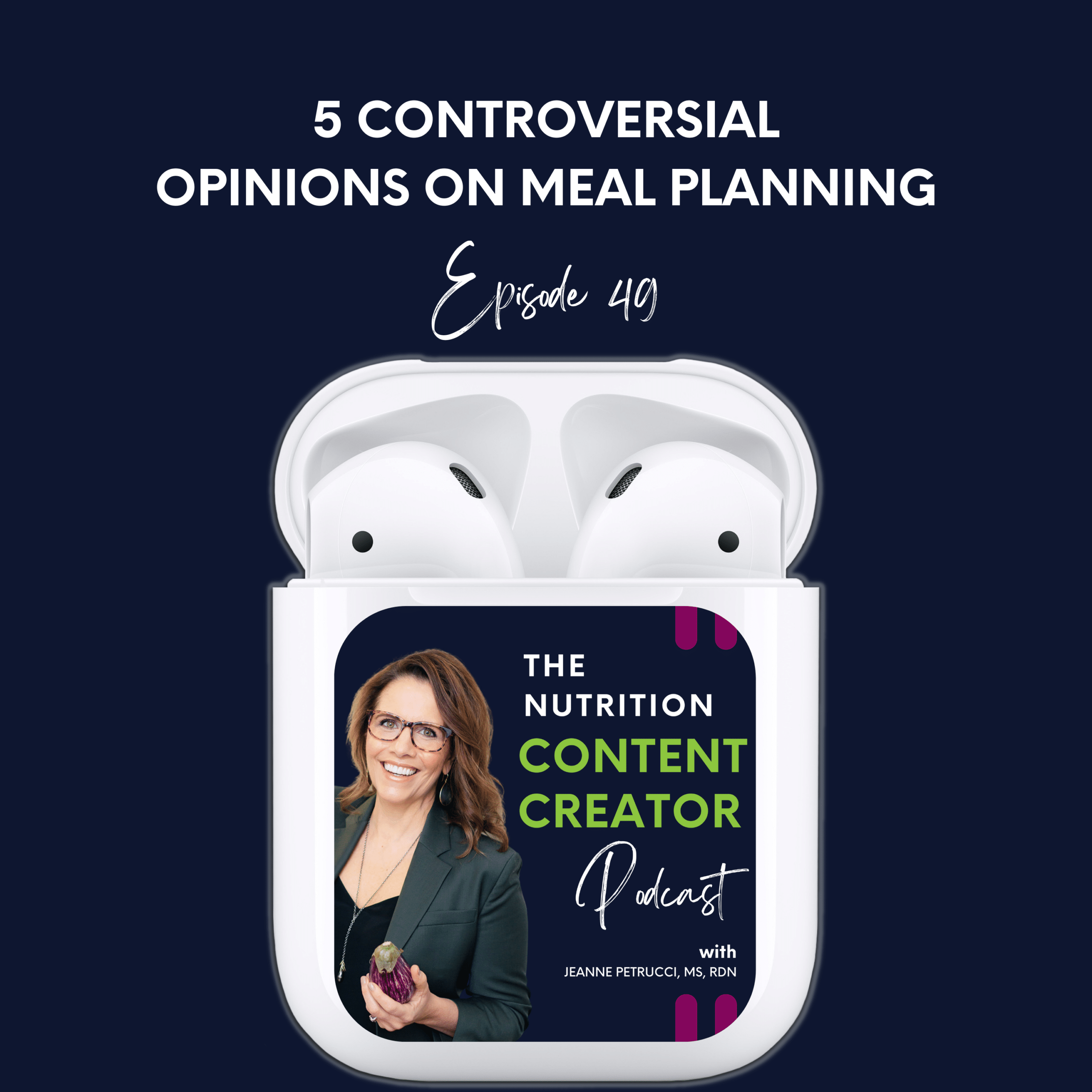14. The Mealtime Method: An Evidence-Based Framework

Today, I’m excited to take a deeper look into a powerful and proprietary framework that lays the foundation for any successful meal plan – The Mealtime Method. This unique approach serves as the backbone of our meal-planning strategy, setting it apart from traditional methods. But what makes The Mealtime Method so special? Well, it’s not just about handing out ready-made meal plans. Instead, it focuses on empowering you to take control of your meal-planning experience. We believe that true success lies in cultivating meal planning autonomy, and that’s exactly what The Mealtime Method aims to achieve. In this episode, we will explore The Mealtime Method in detail, comparing it to conventional meal planning methods. We’ll uncover how this unique framework revolutionizes the way we approach meal planning and how you, too, can implement it in your daily practice. So, buckle up and get ready to embark on this transformative journey of meal planning freedom with us! If you’ve been following our previous episodes, you might remember our conversation in Episode #13, where we first discussed meal plans, exploring best practices and how they can add value to your daily life. If you haven’t had a chance to listen to it yet, I encourage you to do so before joining us on this new journey. Remember, autonomy is the destination, and The Mealtime Method is the road that will take you there. Let’s dive in!
We’ll cover:
- The Mealtime Method versus Traditional Meal Planning Methods
- The Living Plate Rx Mealtime Method Framework
The Mealtime Method versus Traditional Meal Planning Methods
When comparing The Mealtime Method to more traditional, recipe-driven meal planning approaches, there are several advantages to our method. In traditional methods, meal planning often involves adhering strictly to predetermined recipes and portion sizes. While this can provide a structured plan, it often does not account for the individual’s food preferences or encourage the development of independent meal-planning skills. This can lead to a dependence on meal plans, which, while useful initially, doesn’t foster the self-sufficiency necessary for long-term dietary success. Also seen is the practice of giving clients lists of foods that they “should” eat. This leads to overwhelm and stress, particularly for those that lack culinary confidence. So what if we could educate clients on the foods that align with their nutrition prescription and translate these foods into simple delicious recipes? This is where the magic happens. And, if clients repeat the process often enough, they will soon be meal planning with joy and ease – making delicious meals and snacks that not only support their health goals but honor their preferences. The Mealtime Method fundamentally shifts the approach to meal planning by focusing on building skills rather than just following recipes. This method encourages individuals to take ownership of their food choices and become active participants in their health journey. With The Mealtime Method, meal planning is seen not merely as a series of prescriptive recipes to follow, but as an opportunity to learn how to construct balanced meals based on personal taste and nutritional needs. It’s about creating a diet that is sustainable and enjoyable in the long term, as well as being beneficial to health. The core idea is to equip clients with the skills to transition from relying on predetermined meal plans to being able to create their own. Rather than solely providing a fish, The Mealtime Method teaches individuals how to fish, promoting dietary autonomy and fostering a healthier relationship with food. This comes with time and increased culinary confidence.
The Method
The Mealtime Method streamlines the process of creating nutritionally balanced meals weekly – meals that support specific nutrition prescriptions. It is an innovative strategy that moves beyond traditional meal planning. It promotes a more holistic view of food, prioritizing the quality and nutritional composition of ingredients, rather than reducing them to data, such as caloric content or macronutrient percentages. This approach aligns with the modern understanding of nutrition science, which underscores the importance of the nutrient density and overall healthfulness of our diet rather than just the energy it provides. Whenever my team and I are asked to create a meal plan around a particular protocol we do not start with the recipes or data – we start with the whole foods that contain nutrients and compounds associated with driving positive outcomes for a particular nutrition prescription. We then use these foods to create recipes and a plan that, at the end of the day, gets the right mix of foods on the plates of your clients. At its core, The Mealtime Method stratifies meal components into six critical categories, each with a suggested number of choices for the week. The number of choices does not reflect the number of servings – it just encourages variety. Clients can purchase multiple servings of different foods to create a week of nutrient-rich meals.
- Low Glycemic Vegetables (6 selections per week): These include vegetables with a low Glycemic Index (GI), to support balanced blood glucose levels. These types of foods are beneficial for energy management and weight control. Examples include leafy greens, broccoli, cucumbers, cauliflower, and bell peppers.
- Starchier Vegetables and Whole Grains (5 selections per week): These are rich sources of complex carbohydrates that supply the body with sustained energy. They are often packed with dietary fiber, promoting digestive health and providing a sense of satiety. Think along the lines of sweet potatoes, beans, winter squash, quinoa, or whole-grain bread.
- Fruits (4 selections per week): Fruits, besides providing a natural sweetness to meals, are treasure troves of essential vitamins, minerals, and potent antioxidants. The options here are vast, from berries and citrus fruits to apples and bananas. Fruits play an important role in the snack and breakfast categories of meal planning.
- Proteins (3 selections per week): Proteins play a critical role in building and repairing tissues, manufacturing hormones, and supporting immune function. They also contribute to the feeling of fullness after a meal. Proteins can come from both animal and plant sources, such as chicken, fish, tofu, dairy, or eggs.
- Healthy Fats (2 selections per week): Healthy fats are integral for vitamin absorption and protecting vital organs, including the heart and brain. Avocados, nuts, and seeds are excellent sources of healthy fats.
- Flavor Enhancers/Seasonings (1-2 selections per week): This category includes dressings, sauces, or spices that amplify the taste and pleasure of meals. By adding layers of flavor to meals, they help make nutritious eating a more enjoyable and sustainable habit.
It’s no mistake that The Mealtime Method is HEAVY on plant foods as evidence suggests that a diet rich in plant foods is health-promoting and disease protective. By providing structure yet allowing flexibility within these categories, The Mealtime Method promotes diversity in meal planning, ensuring an optimal mix of essential nutrients while catering to individual tastes and preferences. Lastly, the Method also allows for the inclusion of minimally processed foods that can support clients in the kitchen – foods like jarred tomato sauce, frozen pizza crust, pre-chopped produce, frozen meatballs, instant oatmeal, and frozen waffles.
Flexibility
What I love about this framework is the flexibility it brings to the table while still considering specific foods that translate nutrition prescriptions into what’s on your client’s plate. The Method uniquely considers both taste preferences AND nutritional needs. With your guidance, clients are given the freedom to plug foods they enjoy into each category. While doing this they are also educated on the different categories and how they contribute to the transformation they are looking for. Let’s take a look at how it works when creating a 4-week meal plan [in the Content Cure this week I am including some worksheets for you to complete this exercise.] STEP 1: Nutrition Prescription We start with a nutrition prescription [the evidence] for a particular condition – prediabetes. Evidence suggests that prediabetic people can reduce the risk of developing diabetes and improve the management of blood sugars by consuming a diet that contains lower glycemic index foods, antioxidant-rich foods, and foods that are high in fiber.
STEP 2: Preferences Then, assess the client’s preferences. The category I saw most clients struggle with was the low-glycemic vegetable list so I created a preference sheet to guide them through making selections for this category. Once they checked off what they liked, filling in the Method for four weeks was easy. Other things to consider: Is the client vegetarian? Do they have allergies? What are cultural foods important for them to include?
STEP 3: Selections Now for the fun part, fill in the framework, adding whole foods to each category, as if you were doing it with a client. Keep in mind that not all foods will be cooked as part of a recipe – finger foods like cucumbers, carrots, and raspberries can be utilized for snacks. Including plenty of colors will also ensure a variety of antioxidants are represented. 
Once the framework is filled in, take a broad look across categories and you’ll likely see some natural pairings that would come together for simple meals. I always found it easiest for clients to start with a protein: Shrimp + Lemon Garlic marinade + Broccoli + Whole-Grain Pasta Chicken + BBQ Seasoning + Butternut Squash Tofu + Bok Choy + Carrots + Sesame Seeds Kale + Sweet Potatoes + Pecans + Lemon-Garlic Dressing
STEP 4: Creation of the Meal Plan It is only at this point that you can start selecting recipes that support a given nutrition prescription and begin creating a meaningful meal plan. This is where the digital meal planner serves as the ultimate resource. Search ingredients on the list from within your recipe box and begin populating the planner. You do not need to include all foods and as you navigate through the development of the meal plan you and the client may even want to edit the original list [sometimes recipes can inspire inclusion of other appropriate foods!] It is easiest to start with dinner as this is the meal people spend the most time on. I do not recommend you select a full week of dinners – begin with 2-3 and recommend that clients increase the number of servings to enjoy leftovers the next day. Then fill in lunch with leftovers and simple no-cook recipes and proceed to breakfasts and snacks – always referring back to your list. You will note that items like onions, garlic, yogurt, cottage cheese, cheese, and other kitchen and pantry staples do not appear frequently on our pre-populated lists. This is because they are almost always included in recipes or as a component of snacks. Feel free to edit and include if you want clients to focus on these foods.
STEP 5: Repeat Once your client has completed two weeks of The Mealtime Method, they will know if they are selecting the right types of recipes. This is where the counseling process is CRITICAL. Use motivational interviewing to investigate their confidence and success in hitting some key goals. Were they able to make three snacks from the plan? How did dinners go? Make adjustments and move forward until your clients find their sweet spot and have a repertoire of recipes that worked for them. You can move forward with week #2 or simply repeat week #1 with different recipes. If you have used the Method properly and provided adequate support, by the end of 4 weeks, your client’s confidence should be soaring.
Your Content Cure for This Week
And now, we’re at the portion of the show that I know so many of you look forward to – your ‘Content Cure’ for the week.
>> DOWNLOAD YOUR MEALTIME METHOD RESOURCES HERE<<
For this episode, we’ve put together a Guide to Using The Mealtime Method plus some additional tools. In this Content Cure, you’ll find guidance for using the Mealtime Method as part of the nutrition care process as well as some resources you can use with clients, like method worksheets, pantry and kitchen guides, and a low-glycemic vegetable preference sheet. You can access all resources by clicking the link below in the show notes. Start exploring and let us know how you’re implementing The Mealtime Method in your practice.
Key Takeaway
Let’s summarize our conversation today about using an evidence-based approach to meal planning:
- The Mealtime Method offers several advantages over traditional meal planning approaches, which are often rigid and don’t account for personal food preferences.
- Traditional methods can lead to dependency on meal plans and overwhelm, particularly for those who lack culinary confidence.
- The Mealtime Method shifts the focus to building meal planning skills, encouraging individuals to take ownership of their food choices.
- The core idea is to equip clients with the ability to create meal plans based on their personal tastes and nutritional needs.
- The Mealtime Method focuses on creating meals that are nutritionally balanced and palatable, and that align with specific nutrition prescriptions.
- The Mealtime Method promotes dietary diversity and allows for the inclusion of minimally processed foods that can support clients in the kitchen.
- It provides flexibility in meal planning, allowing for the integration of individual food preferences, dietary needs, and lifestyle factors.
- The aim is to help clients develop a repertoire of recipes and dietary habits that work for them and can be maintained in the long term.

Jeanne Petrucci MS RDN
Founder, Expert Nutrition Content Creator


